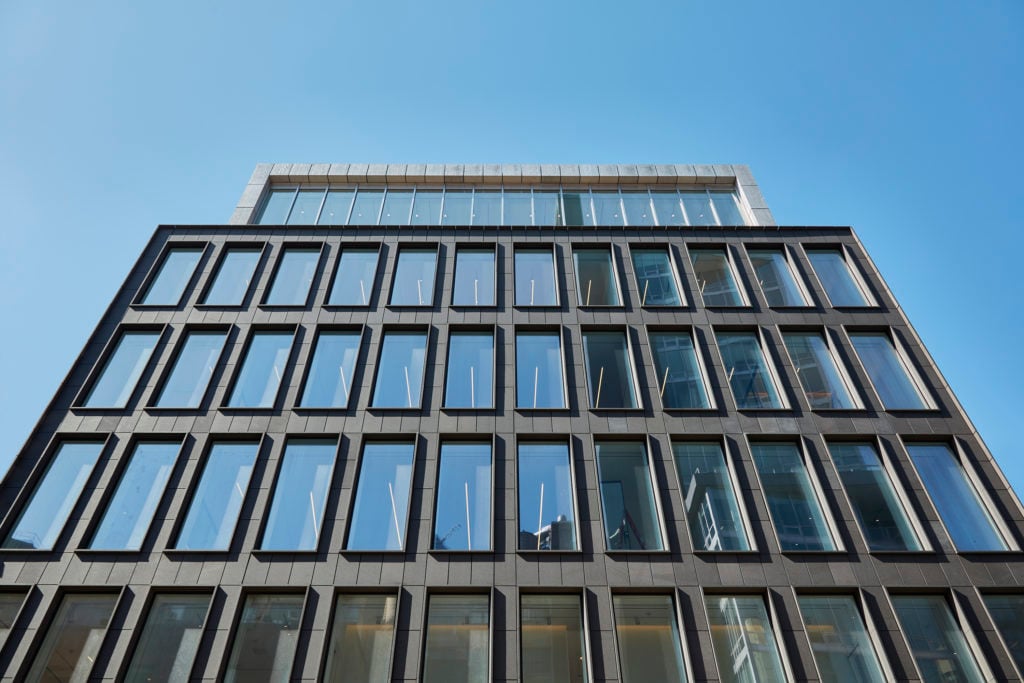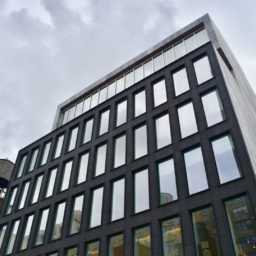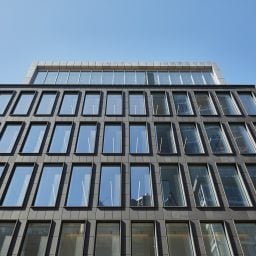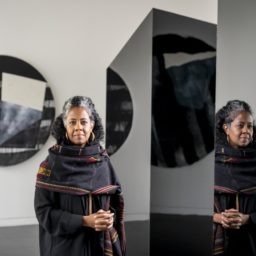“People always ask me, ‘Did you ever imagine?’”
This was how Pace founder Arne Glimcher opened his remarks at the unveiling of his gallery’s gleaming new eight-story, roughly 75,000-square-foot headquarters in Chelsea Tuesday morning. The unnamed object of his question was not just the building clad in 900 panels of volcanic stone that is now Pace’s central nervous system. It was also an allusion to the organization at large and the globe-spanning, cross-disciplinary program the building was designed to serve, at a cost of tens of millions of dollars.
Glimcher has an answer for that question: “No, but it’s not about imagining,” he told the assembled crowd of artists, staffers, and journalists. “It’s about seizing the moment and knowing what’s relevant to the time.”
Judging from the structure now sited at 540 West 25th Street, what Pace’s leadership believes to be relevant to 2019 and beyond is a counterintuitive redefinition of the gallery model. What remains to be seen, however, is whether their bold vision can overcome the considerable practical challenges Pace has accepted to chase it.
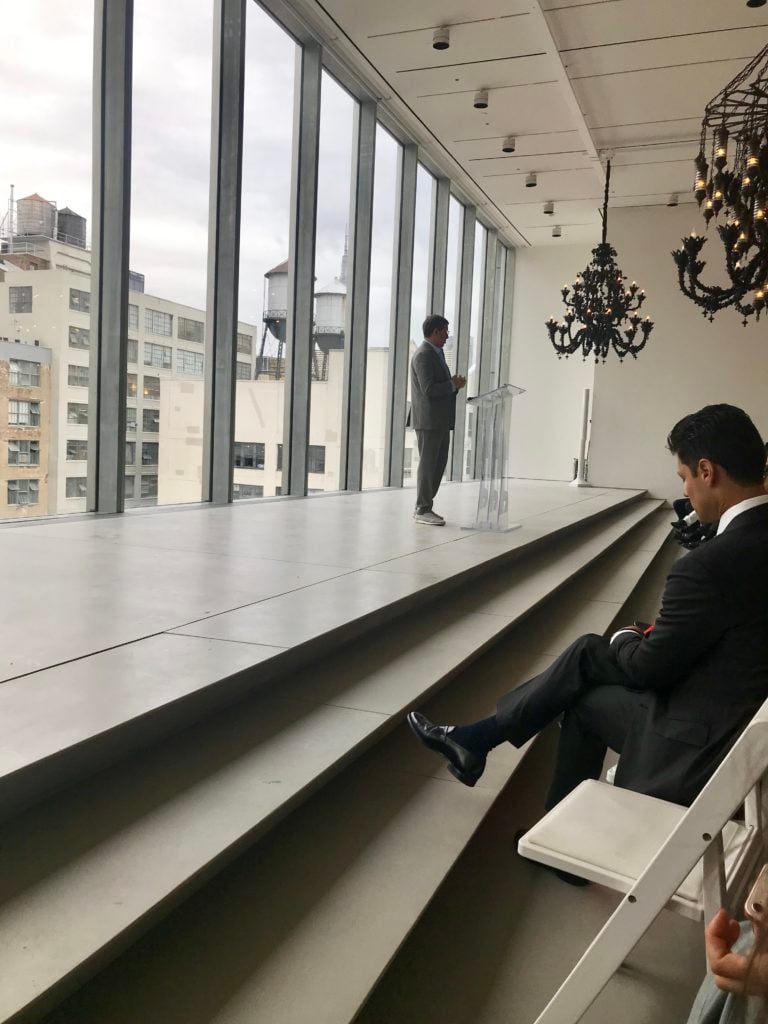
Pace Gallery president and CEO Marc Glimcher during his opening remarks during the unveiling of the gallery’s new headquarters. Photography by Tim Schneider.
Pace Past, Present, and Future
No one is more responsible for this vision than Marc Glimcher, who has been the gallery’s public face and driving force for change since being named its president and CEO in 2011. During a public talk at the 92nd Street Y with author and Vanity Fair editor Michael Shnayerson the night before, Arne credited his son with convincing him that Pace should think bigger—and specifically, higher—during their early conversations about the gallery’s need for more New York real estate roughly four years ago.
Arne said that, at the time, he thought they should just take “two or three floors” of a new building. But in Arne’s telling, Marc argued that the organization should “consolidate” by building “a vertical Pace gallery instead of a horizontal one.”
Marc prevailed. Pace’s new headquarters is quite literally stacked with potential: three levels of versatile, column-free indoor galleries; two levels of office space; one open-air level for outdoor sculpture; one interior level for Pace Live, the gallery’s fledgling performance, new-media, and event program; and an uppermost level of private viewing space, including a rooftop sculpture garden.
Also included in the stack: an over-10,000-volume research library, an outdoor terrace gallery, a dining room for private events, and, according to Marc, enough open storage space to house 500 to 600 sculptures. The gallery even acquired a food truck for the outdoor sculpture area.
All of the above is intended to push Pace out of a retail-gallery mindset and into a new life as a “communal space for thinking, transcendence, and contemplation,” as the younger Glimcher put it in his portion of the opening remarks Tuesday morning. “The idea is that art is for everybody,” he said, not just “intellectuals.” Following this vision would allow Glimcher and his team to “build a new kind of inclusive organization.”
Notably, this sense of inclusiveness is as crucial to Pace’s inner workings as to its relationship with the public. Glimcher told artnet News during the preview that he also sees his gallery’s new flagship location as an adaptation of the campus model favored by Silicon Valley tech giants like Facebook, Apple, and Google: a nucleus of talented personnel, top-flight business resources, and copious amenities condensed into a single all-purpose location so that collaboration and cohesion can flourish.
“Everybody gets so siloed in the art world because you’re always on the move,” says Glimcher. Whether caused by scurrying between multiple locations across Manhattan or between international art fairs and biennials, such nomadic isolation only exacerbates the dangers that many, if not most, successful galleries face by operating as what he calls “personality cults” wholly attuned to the vision of their namesake founder(s) alone. “If we don’t transform that, you put all this effort into a building, and it’s over when the founder croaks,” says Glimcher.
He maintains that the only way to avoid this fate is to “institutionalize” a gallery’s knowledge, skills, and perspective. “You’re going to create leadership teams and all these things they talk about in Silicon Valley, and you’re going to create a way a vision can continue beyond a person. That’s what we’re trying to do.” Concentrating as much of your best personnel as possible in one headquarters juices this process—and Glimcher contends that it is already paying dividends for Pace.
Which would be a major positive for the gallery in light of some of the new building’s frankly stunning risks and realities.

Installation view of Alexander Calder, “Small Sphere and Heavy Sphere,” at Pace Gallery, 540 West 25th Street. September 14–October 26, 2019. Photo: Tom Powel Imaging. © 2019 Calder Foundation, New York / Artists Rights
Society (ARS), New York
A New Lease on Life
Since getting my first art job 14 years ago, I have analyzed a lot of statements by a lot of gallery leaders about a lot of major new endeavors. But it wasn’t until yesterday’s Pace preview that I heard one that included a thank-you to “our fearless landlords, who took this journey along with us.”
That was Marc Glimcher’s reference in his opening remarks to Weinberg Properties, the developer and owner of 540 West 25th Street. It was a bracing reminder that, while Pace worked with Bonetti/Kozerski Architecture to design the structure and pumped a reported $18.2 million into its interior build-out, the gallery does not hold the deed to the property.
Instead, Pace has agreed to a 20-year lease that begins at a rate of roughly $112.66 per square foot, according to the Art Newspaper, and increases by three percent annually, per information from the Kroll Bond Rating Agency. Based on Pace’s description of the building as “approximately” 75,000 square feet, that rate would commit the gallery to paying in the neighborhood of $704,000 in monthly rent in its first year, totaling about $8.45 million overall. Accounting for the escalating interest rate, the entirety of the lease would cost the gallery over $220 million in rent.
Combined with the aforementioned $18.2 million budget to customize the interior and the reported $80 million cost of the building’s shell, Pace’s new headquarters could therefore force the gallery to cough up close to $300 million by 2038. (An inquiry to a gallery spokesperson regarding whether Weinberg Properties paid any portion of the construction costs was not returned by publication time, nor is it known whether other provisions in the lease might lower Pace’s material costs, as is relatively common in real-estate deals of this nature.)
And regardless of Pace’s exact monetary obligation, assuming all goes well, the gallery’s reward in another 18 years will be… to either negotiate a new lease, or move out.
Asked about the financial demands of the new flagship, Marc Glimcher told artnet News, “It’s super expensive. Super expensive. Because you’re gambling that all those good things”—the vertical integration, the collaborative approach, the pristine and versatile new exhibition spaces—”are going to add up to enough revenue to keep the thing rolling.”
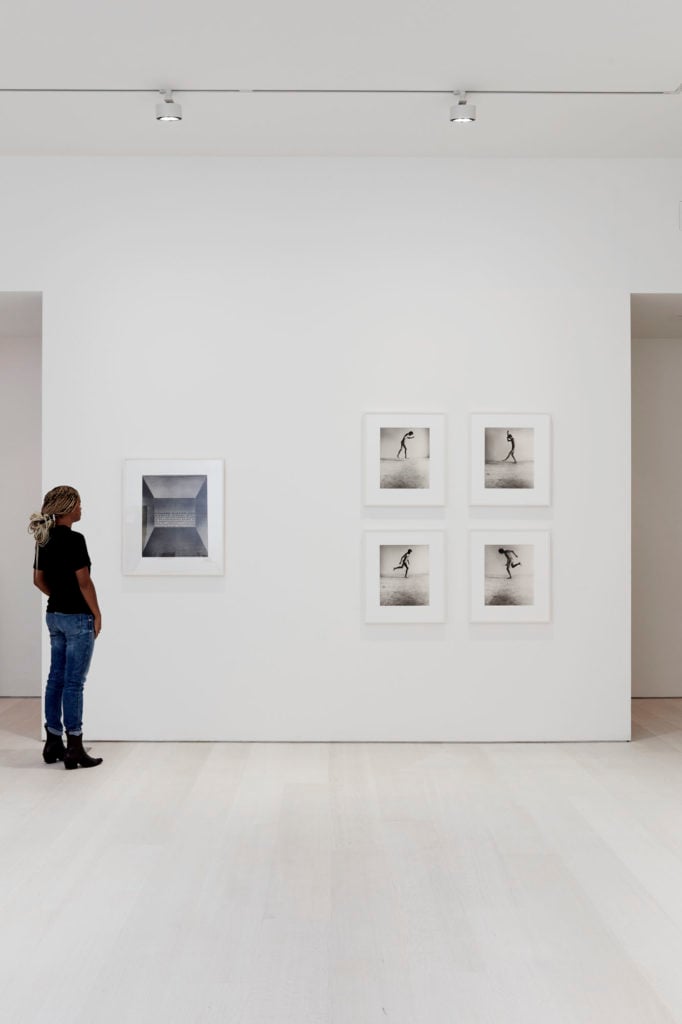
Installation view of
“Peter Hujar: Master Class” at Pace, 540 West 25th Street, New York. September 14–October 19, 2019. Photographed by Jonathan Nesteruk, courtesy Pace Gallery.
The Amazing Shrinking Mega-Gallery
About those new exhibition spaces….
Touring the open levels of Pace’s new headquarters led me to another jarring experience on preview day. One way to describe it would be to say that the galleries felt far more intimate and approachable than I anticipated from an approximately 75,000-square-foot behemoth. Another would be to say that they felt… kind of small? Even a bit cramped at times?
I know, it sounds ludicrous! Part of the effect is undoubtedly a result of the curation and exhibition design of the current shows. The ground-floor gallery hosts Alexander Calder’s “Small Sphere and Heavy Sphere,” a capsule history of the mobile that carves the space into a series of curved corridors and smaller galleries more amenable to the domestic scale of the works on view. Pace also decided to mount three shows—David Hockney’s “La Grande Cour, Normandy,” Peter Hujar’s “Master Class,” and an ensemble of African and Oceanic antiquities from Pace/MacGill—on the third floor, which, at only 1,900 square feet, is already the most compact in terms of exhibition space. (The second-floor galleries allowed Loie Hollowell’s saturated, low-relief abstractions to breathe perfectly easily.)
Circumstance didn’t help the gallery’s cause, either. No sculptures were installed on the open-air sixth floor in time for the preview, and the only presence on the impressively wide Pace Live stage was a lucite podium, a wireless mic, and the Pace speakers who came up to use them one after the other. This program also gave the series of Fred Wilson chandeliers hanging overhead the feel of artworks hastily installed by tenants right after moving into a new apartment in a bid make the place look at least a little alive.
But the surprisingly miniature affect of the supposedly maximal new Pace isn’t entirely situational, either. In fact, it is baked into the structure to a startling degree. Using the square-footage numbers in the press kit’s fact sheet, below is a chart I created to illustrate how the approximately 75,000 square feet of 540 West 25th Street was custom-built to be used.
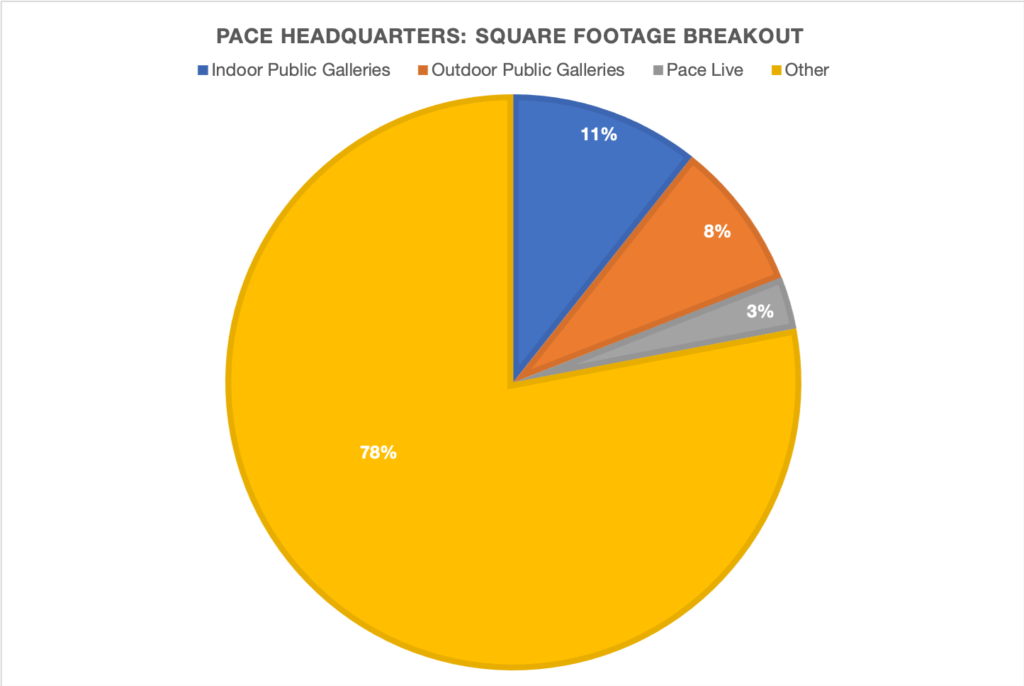
Breakout of space usage in Pace’s new approximately 75,000 square foot Chelsea headquarters. ©Tim Schneider.
In fairness, this chart is a little deceptive. The “other” space includes the private viewing rooms, storage for inventory, and the research library, where small exhibitions will be held. (The space currently hosts a show of Yto Barrada’s wallpaper and works on paper.) The offices, too, double as viewing rooms, as any dealer will tell you. So it’s not as if that entire sprawling wedge of gold on the chart above offers Pace zero opportunities to actually sell artwork.
Still, it is remarkable to me that leadership chose to reserve only 16,500 square feet of public exhibition space across five floors—just over 10,000 square feet of that space being indoors—in a roughly 75,000 square foot mega-gallery that may cost them around $300 million to occupy temporarily.
For comparison, that’s only about 50 percent more space than Lehmann Maupin bought (emphasis on “bought”) in a Chelsea tower for $27 million, according to Brook Mason, and less than half the square footage gained by Gagosian when it recently agreed to rent the spaces vacated by Mary Boone and Pace on West 24th Street. (It is not known how much of the Lehmann Maupin and Gagosian expansions will be exhibition space versus other functional space.)
Granted, artists in 2019 need much more than just public gallery space to thrive, as Marc Glimcher has emphasized again and again. But the flagship’s composition looks like a high-resolution, Jumbotron freeze-frame of Pace’s hard break from the traditional, salable-object-based gallery model—proof that its brain trust is not just spewing empty rhetoric about adopting an unprecedented approach to contemporary art in the commercial realm.
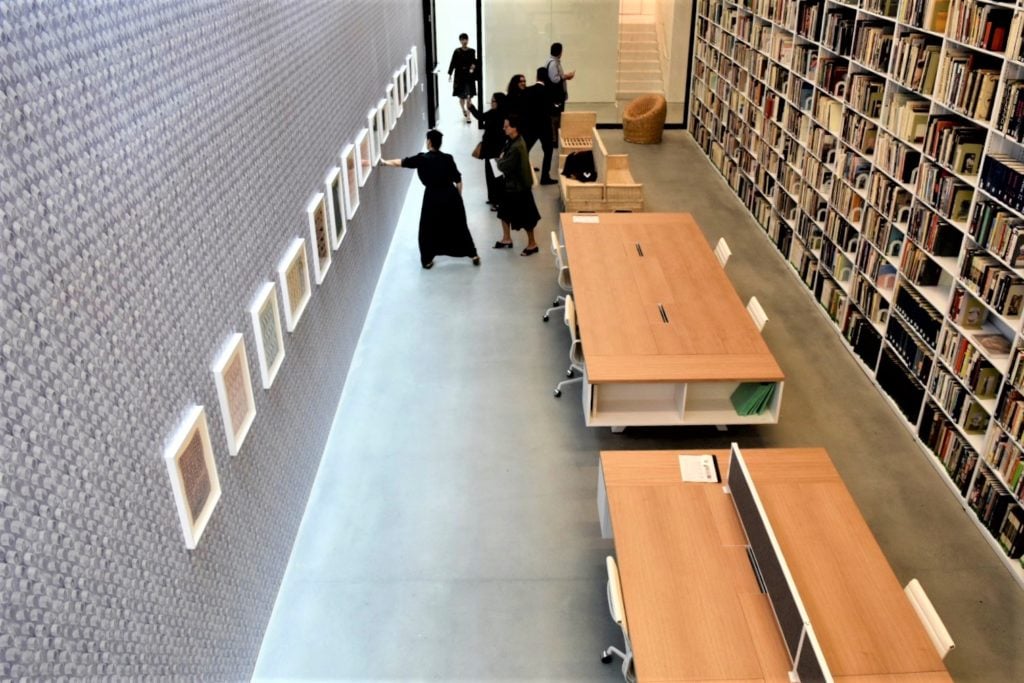
The research library at the new Pace gallery, with works by Yto Barrada (at left). Photo by Ben Davis.
Rolling With the Punches
Even with all these caveats, the element of Pace’s expansion that most makes me squirm like a stomachful of tainted ceviche is how much of it stemmed from Weinberg Properties’ negotiating leverage. Asked whether the gallery would have made such an Olympic leap of faith if his landlords hadn’t already decided they would develop 540 West 25th Street as an arts hub with or without him, Glimcher told artnet News, “You want the real answer? Yes, the Weinbergs made it happen,” adding that “a strategy is something that happened in the past and it worked. Then you call it a strategy.”
Yet this instance of apparently forced adaptation chimes with the gallery’s early beginnings to an almost eerie degree. In BOOM, his book about the contemporary art market’s explosive growth since the postwar years, Michael Shnayerson recounts how, after moving Pace to New York from Boston in 1963, a young Arne Glimcher had to assemble a roster of artists after the city’s heavyweight dealers had already absorbed entire avant-gardes whole. Leo Castelli had a monopoly on the Pop artists. André Emmerich had a monopoly on the color-field painters. Who was left?
Glimcher termed them “highly individualistic” artists, meaning ones who could not be easily assembled under the banner of a single dominant aesthetic or working philosophy. A few years in, the headliners included Louise Nevelson, Robert Irwin, Agnes Martin, and Lucas Samaras, all of whom stayed with the gallery for decades. The elder Glimcher name-checked all four of these artists near the close of his remarks on Tuesday morning as “key people I owe everything to,” adding that the only reason he had access to Samaras was because “Castelli didn’t want him, and [Sidney] Janis was afraid of the work.”
In other words, being pressured by circumstance to zig when everyone else had zagged worked extraordinarily well for Pace before. The situation led Arne, his gallery, and eventually his son, to adopt what Arne described at the 92nd Street Y as “a particular point of view” based on the notion of art as “a tool by which society extends its perception.” (He then went on to explain how this approach differentiated Pace from its mega-gallery competitors, saying, “We do not have a perfume. We are not trying to make a lifestyle gallery.”)
It is a generational symbol of the art market that real-estate pressure—combined with Silicon Valley management philosophy—is now shaping the way Marc Glimcher to trying to match the bold moves that artistic pressure drove his father to make roughly 55 years ago. But that doesn’t mean his own counterintuitive vision can’t succeed just as spectacularly.
Arne Glimcher closed his remarks about the new space (and the new Pace) by musing, “As old as I am, I’m still subject to wonder.” Perhaps his coda should serve as a reminder that everything seems impossible until someone actually does it. Either way, I don’t think we’ll need to wait until 2038 to find out whether Pace’s greatest gamble yet pays off.
